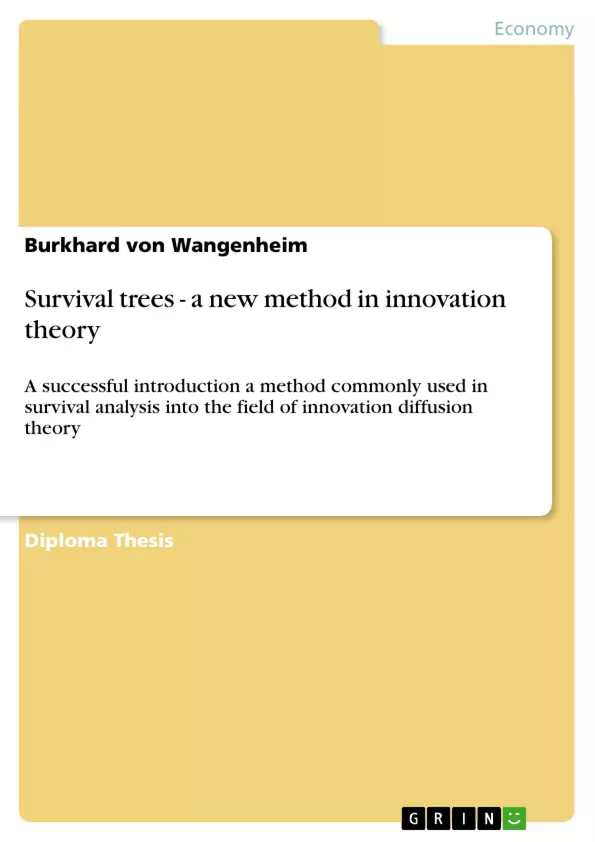The thesis deals with survival trees and their application to the analysis and prediction of innovation processes. The purpose of the conducted research was (1) to investigate the appropriateness of survival trees for innovation diffusion research by means of an application of the method to a real dataset, (2) to give an overview of the current state of research on the survival tree method, and (3) to compare survival trees to more established methods of event history analysis, such as hazard rate models, in order to discuss both advantages and disadvantages of survival trees vis-à-vis alternative approaches.
Inhaltsverzeichnis (Table of Contents)
- 1 Introduction
- 1.1 Context of Thesis
- 1.2 Contribution of Thesis
- 1.3 Structure & Internal Pattern of Thesis
- 2 Modelling Censored Event Data in the Context of Innovation Adoption- and Diffusion Theory
- 2.1 Analysing and Forecasting Innovation Diffusion by Dynamic Micro Models
- 2.2 General Concepts and Terminologies
- 2.3 Statistical Framework
- 2.4 Classical Methods for the Analysis of Event History Data
- 2.4.1 Non-Parametric Methods
- 2.4.2 Parametric Methods
- 2.4.3 Semi-Parametric Methods
- 3 Presentation and Analysis of the Survival Tree Method
- 3.1 Review of CARTTM
- 3.2 Principle Framework & Mechanics of Survival Trees
- 3.3 Splitting, Pruning, Tree-Selection & Alternative Proposals for Survival Trees
- 3.3.1 Splitting - Growing the Saturated Tree
- 3.3.2 Pruning - Generation of Optimal Subtree Sequence
- 3.3.3 Final Tree Selection
- 3.3.4 Alternative Approaches
- 3.4 Final Assessment
- 3.4.1 Assessment of the Splitting, Pruning and Tree Selection Proposals
- 3.4.2 Merits & Deficiencies of the Survival Tree Method
- 4 The use of Survival Trees to Forecast Innovation Diffusion
- 4.1 Applicability of Available Software
- 4.2 Data Description & Handling
- 4.3 Implementation
- 4.4 Results
- 4.5 Discussion
- 5 Summary
Zielsetzung und Themenschwerpunkte (Objectives and Key Themes)
This thesis aims to contribute to the field of innovation diffusion by providing a comprehensive framework for analyzing and forecasting the adoption of new technologies using survival trees. The work seeks to address the limitations of traditional aggregate models and provide a micro-level approach to understanding individual adoption decisions.
- The importance of innovation diffusion in fostering economic growth and competitiveness
- The limitations of existing diffusion models in capturing individual adoption decisions
- The application of survival trees as a powerful tool for analyzing and forecasting innovation diffusion
- The empirical implementation of survival trees to forecast e-purchase adoption
- The implications of the findings for innovation management and policy
Zusammenfassung der Kapitel (Chapter Summaries)
Chapter 1: Introduction This chapter introduces the thesis and provides context for the research. It discusses the significance of innovation diffusion for economic growth and highlights the limitations of existing diffusion models.
Chapter 2: Modelling Censored Event Data in the Context of Innovation Adoption- and Diffusion Theory This chapter provides a detailed overview of the theoretical framework for analyzing and forecasting innovation diffusion. It discusses the key concepts and methodologies used in event history analysis, including both parametric and non-parametric methods.
Chapter 3: Presentation and Analysis of the Survival Tree Method This chapter presents the survival tree method as a powerful tool for analyzing innovation diffusion. It discusses the principles and mechanics of survival trees, including splitting, pruning, and tree selection. The chapter also assesses the strengths and weaknesses of the method.
Chapter 4: The use of Survival Trees to Forecast Innovation Diffusion This chapter demonstrates the practical application of survival trees in forecasting innovation diffusion. It describes the data used in the study and the implementation of the survival tree model. The results of the analysis are presented and discussed in relation to the theoretical framework.
Schlüsselwörter (Keywords)
The primary keywords and focus topics of this work include: innovation diffusion, survival trees, event history analysis, censored event data, dynamic micro models, technology adoption, e-purchase adoption, economic growth, competitiveness, and innovation management.
- Quote paper
- Burkhard von Wangenheim (Author), 2004, Survival trees - a new method in innovation theory, Munich, GRIN Verlag, https://www.grin.com/document/193797



